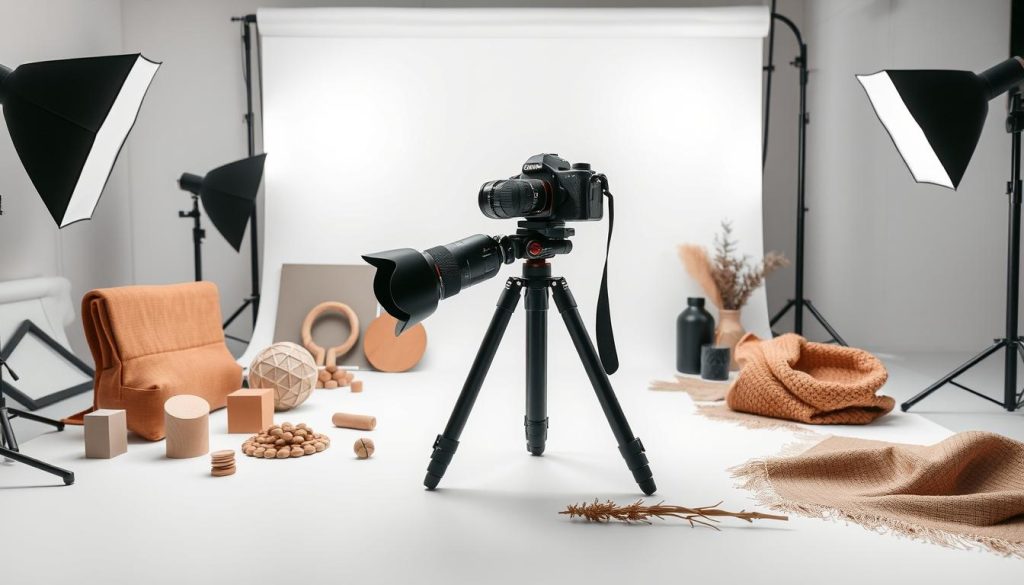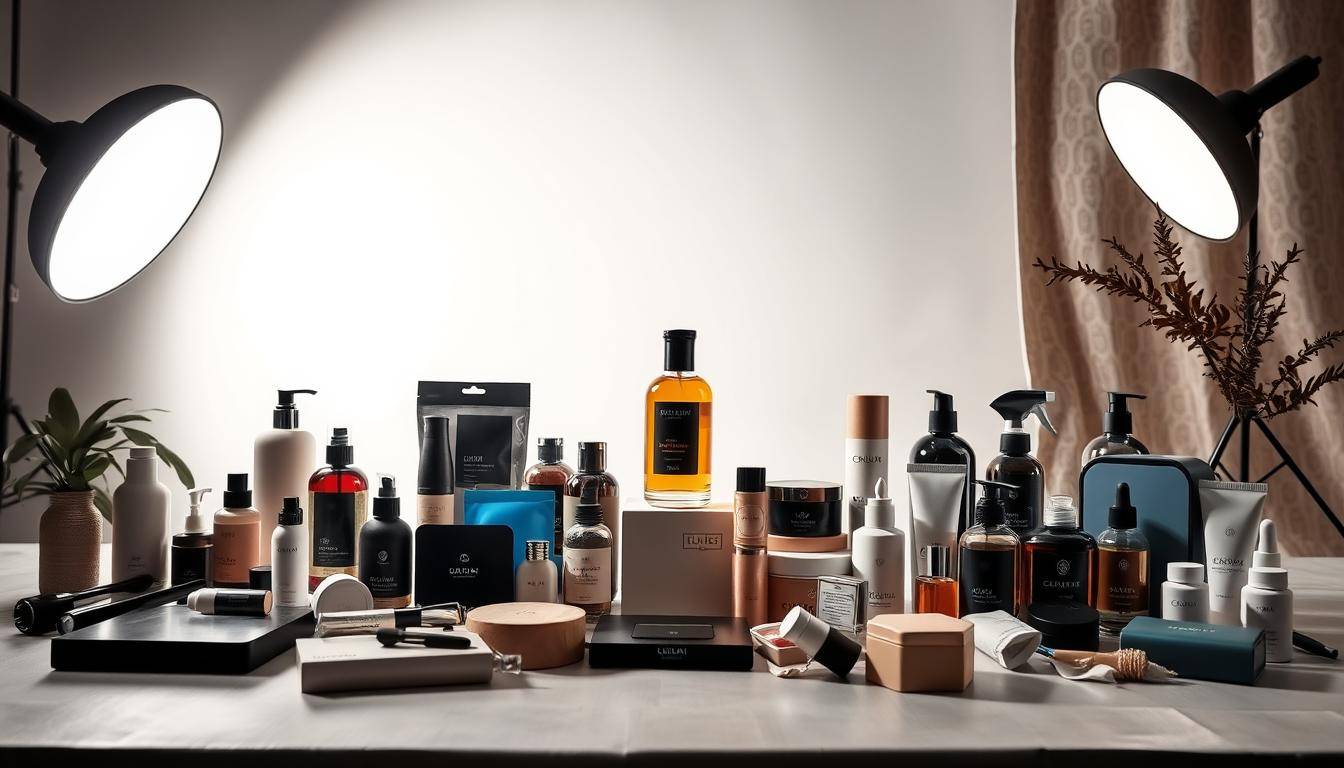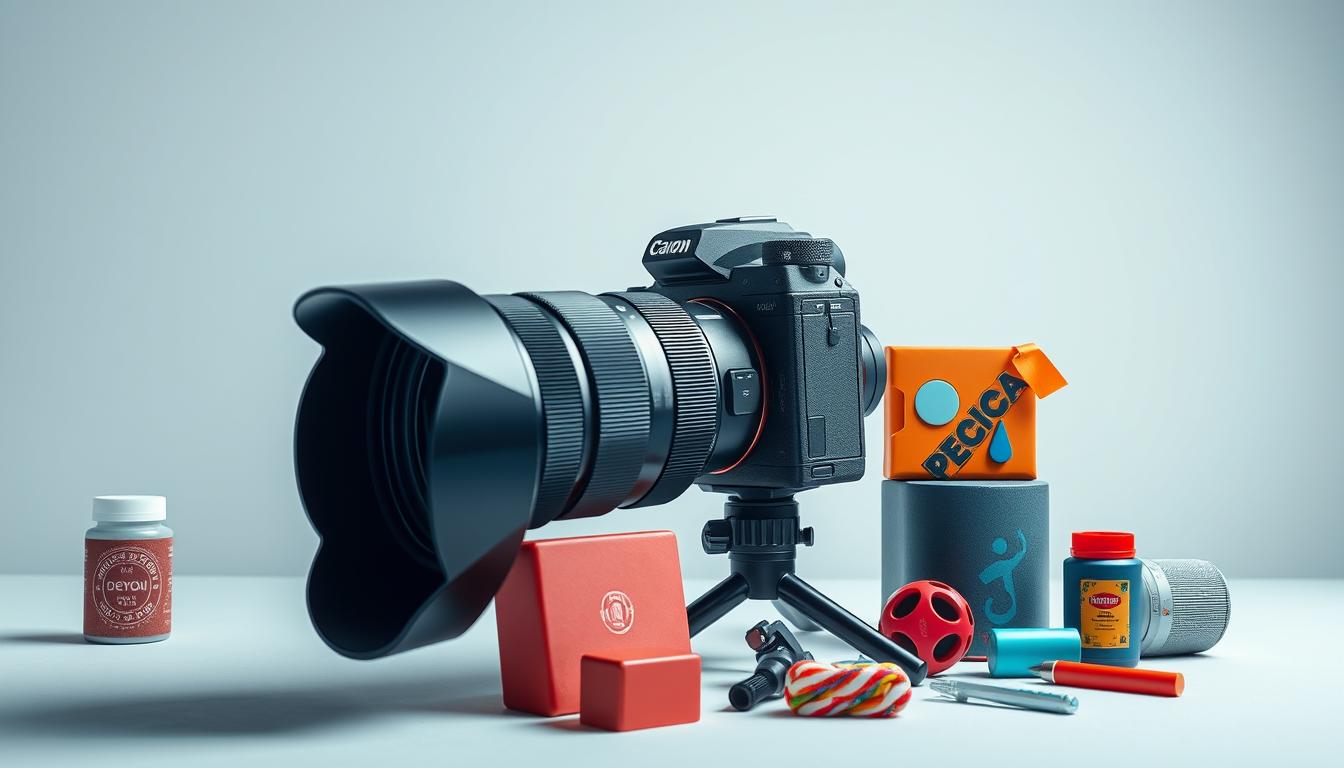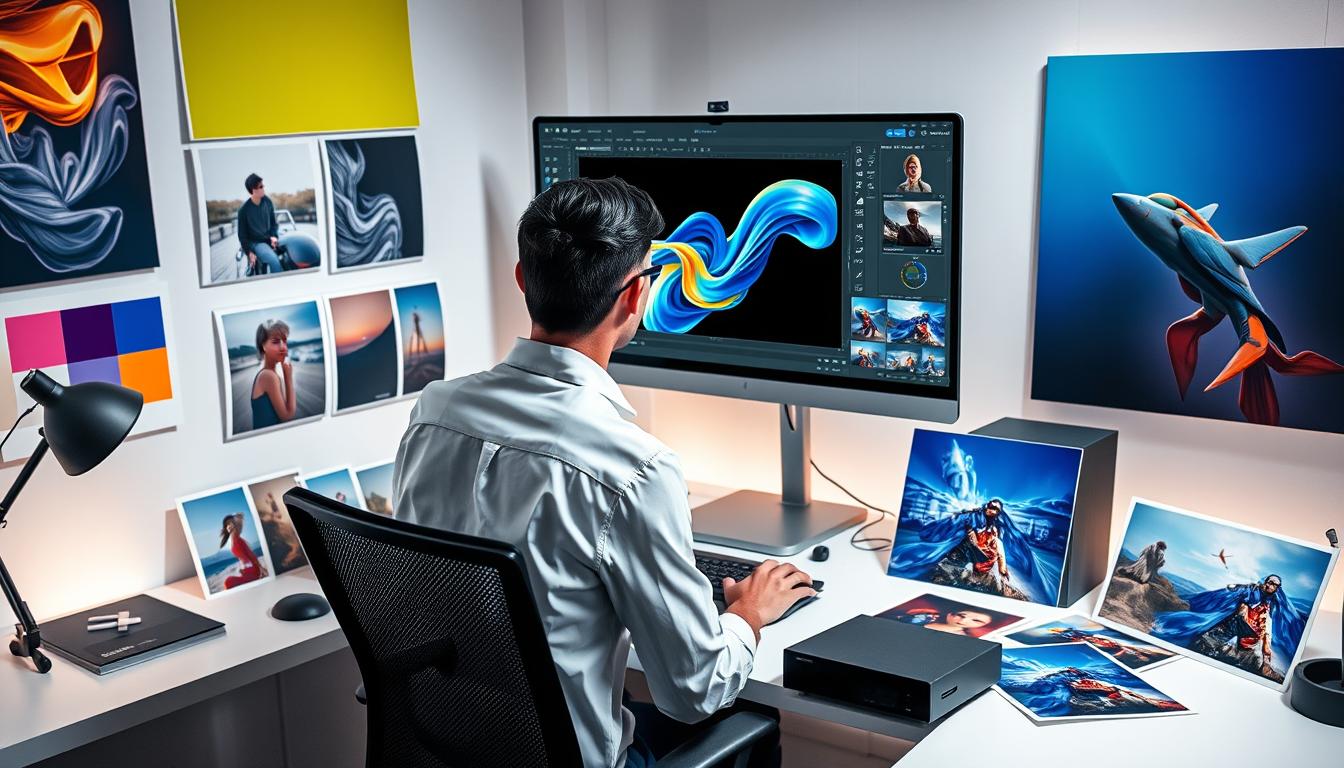In the world of e-commerce, how you show products matters a lot. High-quality pictures can grab attention and help sell more. Effective product photography does more than just show a product. It tells a story that buyers can connect with.
How a product looks in pictures can really affect if someone buys it. There are many product photography styles to choose from. Each style can focus on different things, like what the product does or how it fits into daily life. We’ll look at some top styles to make your e-commerce photos better and increase sales.
Power of Visual Merchandising
Visual merchandising is key in product photography. It affects how customers see and buy products. For retailers, knowing its impact is vital for sales and growth.

How Product Images Influence Purchasing Decisions
Product images are very important in visual merchandising. They give customers a clear look at the product. Good images can make customers trust more and buy less.
By showing products from different sides and in use, businesses help customers choose wisely.
Psychology Behind Effective Product Photography
The psychology of good product photography is about emotions and action. Using smart lighting, setup, and style, businesses can connect with their audience. This can lead to more customers and better sales.
Creative Product Photography Fundamentals
To stand out online, businesses need top-notch product photos. They must know the basics of creative product photography. This means knowing how to mix art with sales goals.
Strategic Approaches in Commercial Photography
In commercial photography, a smart plan is key. It makes images that look good and sell well. Knowing your audience and the product’s best features is important.
Think about these things:
- Find the product’s main features and benefits.
- Know what your audience likes and does.
- Figure out the best way to show the product.
Balancing Artistic Vision with Conversion Goals
Art is important in product photos, but so are sales. Images should look good and sell well. Show the product’s benefits clearly and in a way that grabs attention.
For example, a simple background focuses on the product. Lifestyle shots show how it fits into life.

Setting Up Your Product Photography Workspace
Creating a good workspace needs planning and the right tools. A tidy space makes photos better and more consistent. Think about lighting, backdrops, and props.
By following these basics, businesses can make photos that sell well. They look great and help with sales.
Minimalist Product Photography
In the world of e-commerce, minimalist product photography is key. It grabs people’s attention by focusing on the product. This makes for a more engaging and effective visual experience.
Clean Backgrounds and Negative Space Techniques
Minimalist product photography uses clean backgrounds and negative space. This creates simplicity and elegance. It makes the product pop and reduces clutter.
Photographers often use white or light backgrounds. This neutral setting lets the product shine. It keeps the viewer’s focus on the product.
When Simplicity Drives Sales
Minimalist product photography is not just pretty; it boosts sales. It builds trust with customers. This is true for products like jewelry, luxury goods, and high-end electronics.
Case Studies: Minimalist Success Stories
Many brands have seen sales go up with minimalist photography. For example, a famous jewelry brand got more sales after using it. 
Using minimalist product photography helps businesses look good online. It drives sales and builds trust with customers.
Lifestyle Product Photography
In the world of e-commerce, lifestyle product photography is key. It shows products in real-life settings. This makes them more relatable and appealing to buyers.
Contextual Shooting Techniques
Contextual shooting is vital in lifestyle product photography. It places products in everyday life. This helps buyers see how the product fits into their life.
Elements of contextual shooting include:
- Identifying the target audience and understanding their lifestyle
- Selecting scenarios that resonate with the target audience
- Ensuring the product is the focal point while being contextualized
Creating Aspirational Imagery That Connects
Aspirational imagery tells a story that speaks to the consumer’s dreams. It uses high-quality images that show the product and evoke a lifestyle or feeling. For example, a travel brand might use images of exotic places to make their products seem desirable.
Conversion Metrics for Lifestyle Images
To see if lifestyle product photography works, brands track certain metrics. They look at click-through rates, conversion rates, and sales from campaigns with lifestyle images.
Flat Lay Photography Techniques
Flat lay photography is simple yet powerful. It shows products in a neat and pretty way. This is done by arranging items from directly above.
Composition Strategies for Overhead Shots
To make great flat lay photos, use the rule of thirds and symmetry. Balancing elements in the picture is key for beauty.
Product Categories That Benefit Most from Flat Lays
Some products, like cosmetics, fashion items, and food, look great in flat lays. They often have many parts that can be arranged in fun ways.
Styling Tips for Maximum Visual Impact
To get the most out of your flat lay, add textures, colors, and matching items. Try different setups to find something special.
Learning flat lay photography can help businesses show off their products better. This can lead to more people looking and buying.
360-Degree and 3D Product Photography
In today’s online shopping world, 360-degree and 3D product photos are changing how we shop. These new ways let customers see products from all sides. It makes shopping online more fun and real.
Interactive Product Visualization Methods
With 360-degree views and 3D models, customers can see products up close. This makes them feel more sure about buying things. Interactive visualization is great for products that are tricky to show.
Equipment and Software Requirements
To use 360-degree and 3D photos, you need special tools and software. This includes good cameras, turntables, and 3D software. Even though it costs a bit at first, it helps a lot in the long run. Efficient software solutions make it easier for all kinds of businesses.
Conversion Rate Improvements with Interactive Images
Research shows that 360-degree and 3D photos can really help sales. They help customers understand products better, which means fewer returns. Conversion rate optimization with interactive images is key for online stores to win.
As tech gets better, we’ll see more cool uses of 360-degree and 3D photos online. By using these, businesses can make shopping online better. This can help sell more and keep customers happy.
Scale and Proportion Photography
To keep customers happy, businesses need to show products the right size. This is key for trust.
Communicating Size Effectively to Reduce Returns
Online shopping can be tricky because of size issues. Scale photography helps by showing size clearly. For example, showing a product with a coin or ruler helps customers understand its size.
Creative Ways to Show Product Dimensions
There are many ways to show product size. Size comparison techniques like showing products with known objects work well. You can also add a measurement scale in the image or list detailed specs.
| Technique | Description | Benefit |
|---|---|---|
| Size Comparison | Place product next to known objects | Enhances customer understanding |
| Measurement Scale | Include a scale in the product image | Provides precise measurements |
| Detailed Specifications | List product dimensions in detail | Builds customer trust |
Size Comparison Techniques That Build Trust
Showing product size in different ways helps build trust. By giving many views and comparisons, businesses show they are open and confident in their products.
Detail-Oriented Macro Photography
To really show a product’s quality, macro photography is key. It captures tiny details that can change a sale. By showing these details, businesses can gain trust and more sales.
Highlighting Product Features That Sell
Macro photography is great for showing a product’s small details. For example, in jewelry, it shows a diamond’s sparkle or a watch’s details. These details can really sell a product, as customers like to see what they’re buying.
Technical Requirements for Compelling Macro Shots
To get great macro shots, you need the right tools. A macro lens is a must for close-ups. Good lighting is also key to avoid shadows and show off the product’s features. Some use stacking to get more depth in their photos.
Products That Benefit from Close-up Details
Some products really shine with macro photography. These include jewelry, watches, cosmetics, and electronics. For instance, cosmetics can show lipstick texture or compact powder design. Electronics can highlight a phone’s camera or a laptop’s keyboard.
Color Psychology in Product Photography
Understanding color psychology is key for making product photos that connect with people. The colors in photos can really affect how people feel and what they decide to buy.
Using Color to Evoke Emotions and Drive Action
Colors can make people feel different things. For example, red makes us feel energetic and urgent. Blue makes us feel calm and trusty. By picking colors that match the product’s brand, businesses can connect with their audience on an emotional level.
Background Color Selection Strategies
Choosing the right background color is very important. It should go well with the product and highlight its best features. A good background color can make the product pop and make the photo look better overall.
Color Harmony Principles That Increase Conversions
Color harmony means using colors that look good together. In product photos, using color harmony can make the images more appealing. You can use complementary, analogous, or triadic color schemes to do this.
| Color Scheme | Description | Effect on Consumers |
|---|---|---|
| Complementary | Colors opposite each other on the color wheel | Creates visual contrast and grabs attention |
| Analogous | Colors next to each other on the color wheel | Produces a harmonious and soothing effect |
| Triadic | Colors equally spaced from each other on the color wheel | Offers a balanced and vibrant visual experience |
Lighting Techniques That Enhance Conversion
Learning about lighting is key for product photographers. It helps make images that grab attention and sell. The right light can change how a product looks, affecting what buyers think of it.
Natural vs. Artificial Lighting Approaches
Natural lighting uses the sun to light up products. It makes them look soft and natural. But, it can change with the weather and time.
Artificial lighting lets photographers control the look. It’s steady and can make specific moods. Choosing between natural and artificial light depends on the product and what the brand wants.
Creating Mood Through Strategic Lighting
Lighting can make people feel certain ways. Warm light feels cozy, while cool light looks modern. By picking the right light, photographers can make products more appealing and match the brand’s look.
Product-Specific Lighting Solutions
Every product needs its own lighting. Jewelry and glass need bright, specular lighting to shine. But, soft light is better for clothes and furniture to show their texture.
Using the right lighting can make products look better. This can help get more people interested and buying.
Post-Processing for Conversion Optimization
Good post-processing makes product images look great and sell more. In e-commerce, how a product looks is very important. So, making product images better through editing is key.
Essential Editing Techniques for Different Product Types
Each product needs its own editing style. Clothes might get wrinkle fixes, and jewelry gets sparkly boosts. Knowing what product you’re editing is important.
Some top editing tricks include:
- Adjusting brightness and contrast
- Removing blemishes or imperfections
- Enhancing colors to match brand identity
Maintaining Authenticity While Enhancing Appeal
When editing, keeping the product real is key. Too much editing can disappoint customers. Finding the right balance is essential.
A/B Testing Different Editing Styles for Maximum Impact
Trying out different editing styles can show what works best. By comparing image edits, businesses can make smart choices.
By looking at A/B test results, businesses can improve their editing for better sales.
Conclusion
Creative product photography is key in e-commerce. It helps make products look great online. This includes styles like minimalist and lifestyle photos.
Understanding who you’re selling to is important. You want your photos to speak to them. Using the right techniques can make a big difference.
Good product photos can really help your business. They can make more people buy and feel happy with their purchases. As online shopping grows, so does the need for great photos.
FAQ
What is the best product photography style for e-commerce?
The best style for e-commerce depends on your product and brand. Choose a style that fits your brand’s look. It should show the product in a lifestyle setting or with a simple, clean look.
How do I set up a product photography workspace?
You need a camera, lens, lights, and a backdrop for your workspace. Start with a basic kit. Then, get a lightbox or a photography tent for better control.
What is the importance of 360-degree product photography?
360-degree photos give customers a full view of products. This makes them more interested and can lower returns.
How does color psychology impact product photography?
Colors in photos can make people feel certain ways. Pick colors that match your brand and appeal to your audience.
What are the benefits of using lifestyle product photography?
Lifestyle photos show how products fit into real life. This can make customers more interested and help sell more.
How can I optimize my product images for conversion?
Use high-quality photos from different angles. Try different editing styles and use lifestyle photos to connect with customers.
What is the role of lighting in product photography?
Lighting makes products look good and sets the mood. Mix natural and artificial light to get the right look.
How can I show product dimensions effectively?
Use scale and proportion to show size. Include a reference object or use a lifestyle setting. This helps customers understand size and lowers returns.
What are the technical requirements for macro photography?
Macro needs a macro lens, tripod, and good lighting. Use a camera with manual controls for the best results.
How can I maintain authenticity while enriching product images?
Use subtle editing to make products look better without changing them. Test different styles to find what works best.





